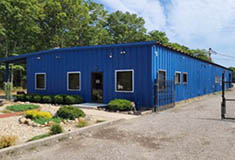Long Island Regional Planning Council releases results of two economic development surveys
Syosset, NY As Long Island businesses continue to struggle amid the COVID-19 pandemic—combined with an increasingly challenged brick-and-mortar retail sector prior to the pandemic—land use across Nassau and Suffolk counties could be altered significantly during the post-COVID-19 economy, according to a new study.
Meanwhile, the Incorporated Village of Farmingdale has gone through a renaissance over the past decade and serves as a model for future downtown revitalizations across Long Island, a new study finds. Further, the short-term negative economic impact from COVID-19 could result in long-term economic growth in Farmingdale and other communities as more people seek suburban living with thriving downtowns nearby.
The Long Island Regional Planning Council (LIRPC), the leading regional planning body representing Nassau and Suffolk counties, commissioned the two studies as priorities for Long Island’s economic development. LIRPC announced the findings during its Council meeting on Tuesday, Sept. 15th.
“There is significant synergy between the two studies as the long-term impact of COVID-19 can dramatically transform land use, such as a growing demand for suburban communities with thriving downtowns as people move away from dense urban housing, to the tremendous measurable economic impact that communities like Farmingdale can realize when they focus on revitalization,” said LIRPC chairman John Cameron.
Nassau County executive Laura Curran said, “With its bustling downtown, attractive housing options and thriving business environment, Farmingdale Village is a great model of Nassau County’s ‘Live, Work, Play’ vision. The Village has proven that supportive zoning policies and creative revitalization programs can make a real impact on the bottom line, bringing more tax dollars to support the school district and other public needs. In these difficult economic times it is even more important to know what strategies are tested and proven and I encourage other municipalities to look to Farmingdale as they develop their own economic resurgences.”
LIRPC retained 4ward Planning Inc. to conduct the two studies. LIRPC entered into a prior consulting services agreement with 4ward Planning in 2018 for an economic impact analysis of the Village of Patchogue, which documented the major economic impact in that thriving Village. Todd Poole, president of 4ward Planning, Inc., presented the latest findings.
“The findings of the two studies announced today prove that across Nassau and Suffolk counties we must address the challenges—and embrace the opportunities—to ensure we have a thriving economy on Long Island as we move past the pandemic,” said LIRPC executive director Richard Guardino.
The study analyzed how major land uses on Long Island are likely to change fundamentally over the near- and long-term for housing, retail, restaurants and entertainment venues, offices, light industrial, and recreation. Key impacts and opportunities from the study include:
• Demand will increase for housing with multi-generation living and slightly larger than the multi-family rentals that have seen explosive growth over the past decade.
• Zoning must adapt to the growing demand for live-work housing.
• Envision a mix of uses for obsolescent shopping malls and retail centers.
• Grow “pop-up” retail in downtowns with significant vacancies due to the economic tumult.
• Repurpose a number of large suburban office parks.
• Light industrial demand will remain strong, as ecommerce and same- or next-day delivery demand increases.
• Municipal parks and trails will benefit from an increase in use, as residents seek safe recreational alternatives to indoor facilities.
The Village of Farmingdale experienced an economic boom over the decade with new destination restaurants, breweries, unique shops, and newly built apartments, replacing older properties and vacant storefronts. The study revealed these key benefits:
• 35 new businesses have opened in the downtown since 2012.
• Farmingdale made over $20 million in capital improvements to its downtown since 2012, which has helped improve and expand parking, improve the streetscape, and create a pocket park, among other notable improvements.
• The economic output to Nassau County from investments made in Farmingdale over the past eight years amounts to nearly $33 million (includes direct labor income and value added). For every $1.00 invested in capital improvement-related construction projects in Farmingdale, approximately $1.74 was generated throughout Nassau County.
• Six multi-family residential projects were developed in the downtown area since 2014, in response to the Downtown Mixed Use (DMU) zoning code adopted in 2011.
• While the six multi-family residential development projects encompass 323 units, only 21 public school age children are associated with these units – or a ratio of 6.5 children per 100 units.
• Over a six-year period, the six newly constructed multifamily residential developments generated approximately $2.1 million in school property tax revenues and an estimated $803,000 in school service costs over the same period. The estimated net positive impact to the Farmingdale School District is approximately $1.4 million over the six-year period.
Farmingdale’s ongoing success could serve as a model for future revitalization in other Long Island downtowns struggling today.
The full studies are available on the LIRPC website at www.lirpc.org through the following links:
Land-Use Impacts Post Covid-19: https://lirpc.org/economic-development/land-use-impacts-post-covid-19
Village of Farmingdale Economic and Fiscal Impact Analysis: https://lirpc.org/economic-development/village-of-farmingdale-economic-and-fiscal-impact-analyses
The Long Island Regional Planning Council comprises public and private sector leaders who are experienced and knowledgeable in business, environment, transportation, and planning. Its main goal is to educate Long Island officials, stakeholders and residents on key issues affecting the quality of life in the region, and it proposes immediate and long-term strategies and solutions. The Council actively identifies and advocates for “Projects of Regional Significance.”
Suffolk County IDA supports expansion of A&Z Pharmaceuticals


The evolving relationship of environmental consultants and the lending community - by Chuck Merritt
When Environmental Site Assessments (ESA) were first part of commercial real estate risk management, it was the lenders driving this requirement. When a borrower wanted a loan on a property, banks would utilize a list of “Approved Consultants” to order the report on both refinances and purchases.









.jpg)